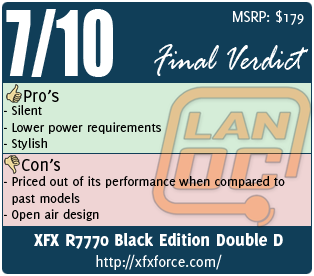 Not everyone can afford to go with the most expensive video cards on the market; most gamers have a more limited budget. This is mostly due to the fact that there are more gamers from the 13-30 age groups than anything else. Between being too young to work, poor college students, and then young budding family’s money is always tight. When your budget has you building a $600 dollar gaming rig there is no way you will be dedicating all or even half of that towards the video card. It’s important for gaming, but without the rest of your components you’re not going anywhere. That’s where AMD’s new HD 7770 comes in, at a price point that still leaves room in your budget. Of course we need to see how it performs, for that we are taking a look at XFX’s R7770 Black Edition Double D overclocked edition.
Not everyone can afford to go with the most expensive video cards on the market; most gamers have a more limited budget. This is mostly due to the fact that there are more gamers from the 13-30 age groups than anything else. Between being too young to work, poor college students, and then young budding family’s money is always tight. When your budget has you building a $600 dollar gaming rig there is no way you will be dedicating all or even half of that towards the video card. It’s important for gaming, but without the rest of your components you’re not going anywhere. That’s where AMD’s new HD 7770 comes in, at a price point that still leaves room in your budget. Of course we need to see how it performs, for that we are taking a look at XFX’s R7770 Black Edition Double D overclocked edition.
Product Name: XFX R7770 Black Edition Double D
Review Sample Provided by: XFX
Review by: Wes
Pictures by: Wes
Specifications
|
Part Number |
FX-777A-ZDB4 & FX-777A-ZDBC |
|
Model |
Radeon HD |
|
GPU |
7770 |
|
Performance Level |
Black Edition |
|
Core Clock |
1095 MHz |
|
Memory Size |
1GB |
|
Memory Type |
DDR5 |
|
Memory Bus |
128-bit |
|
Bus |
PCI-Express 3.0 |
|
Output s |
Mini-DisplayPort Dual Link DVI-I HDMI |
|
Fan Type |
Dual Axial |
|
XFACTOR Features |
• GPU Edging: Black Edition Selection Process • Double Dissipation • Ghost Thermal Technology • Duratec: Solid Capacitors • Duratec: IP-5X Dust Free Fan • Duratec: XFX Bracket |
“Cape Verde”
For those of you who don’t know every video card has a code name, something that is used internally until product launch. AMD has been using different island names for this, a good example would be Tahiti, the code name for the recently launched 7900 series cards. As you can tell from the title of this section, today we are taking a look at Cape Verde. Cape Verde is the code name for the HD 7700 series of cards, more specifically the HD 7770 and HD 7750. The HD 7700 series falls in well below the 7900 series and below the still unreleased Pitcairn series cards. As you can tell from the image below the die size of the Cape Verde cards is considerably smaller than the other two also.
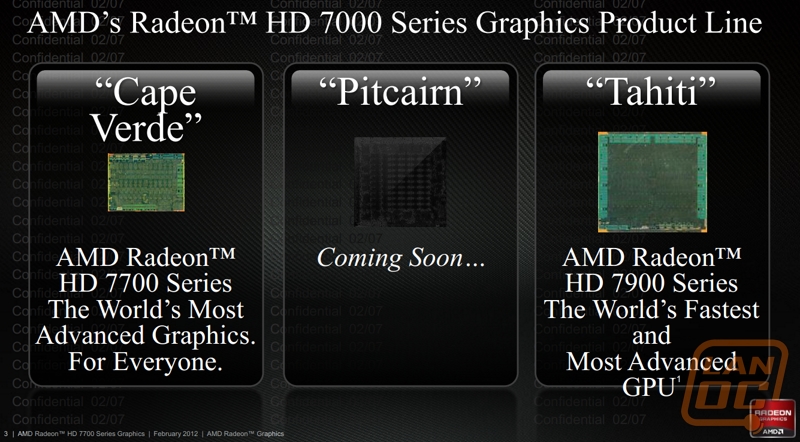
According to Steams Hardware Survey in December the HD 5770 had a 28% market share, well above anything else being used on the market. The reason for this was its good performance, low power requirements, and good price. We here at LanOC have used these cards multiple times in Shuttle and other small form factor builds for those exact reasons. Don’t tell anyone else but one of our editors is still running on in his PC also. It was just that good of a card, but it is getting a little long in the tooth now with games like Crysis 2, BF3, and Batman pushing the limits. That’s where AMD is hoping to step in with the HD 7700 series. It is designed to use low wattage, perform well, and is priced at $159 for the HD 7770. A price point that most should be able to afford, that’s mowing around 8 yards give or take.

It’s important to point out that even though the price is considerably less than the HD 7900 series cards that you still will get all of the same features on the HD 7700 series cards.
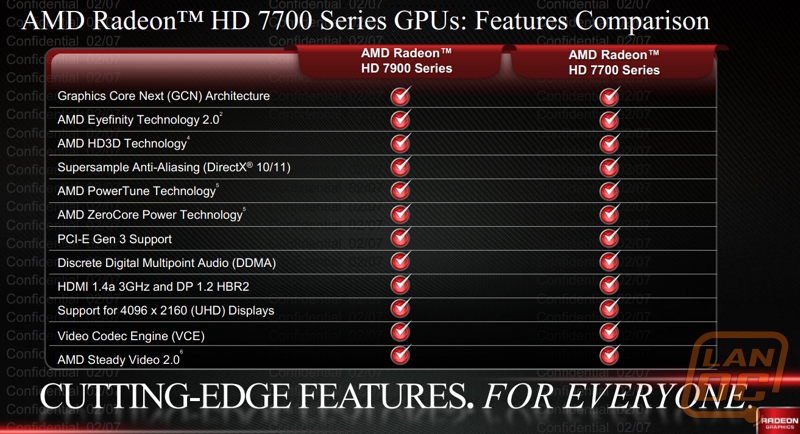
How are they going to give you that performance increase over the original HD 5770 with the HD 7700 series cards? Well for one this is a new architecture unlike the 6770 who shared the same architecture as the HD 5770. The new architecture is based on 28nm technology meaning lower temperatures and a smaller die size. Because of that they are able to fit 640 Stream Processors and 512KB of L2 Read-Write cache. The 128-bit memory interface uses GDDR5 memory with a bandwidth of up to 72GB/s.

Here is the breakdown between both of the card’s specifications. You will find a lot of simularitys but the HD 7750 has been cut down considerably in performance. They did this with a lower clock speed (800MHz to 1 GHz), fewer stream processors (640 on the 7770, 512 on the 7750), and fewer texture units (40 on the 7770, 32 on the 7750). All of that results in less compute performance (1.28 TFLOPS on the 7770, 819 GFLOPS on the 7750) and also allows that HD 7750 to use 25 less wattage while under load.

AMD was very proud to talk to us about how much headroom is still left on each card. Even with the HD 7770 being the first reference card design to be introduced with a clock speed of 1,000 MHz, they still feel that there is more than enough room for overclockers to play.

I mentioned before the difference in power usage between the two cards but I just wanted to point out how great these cards will be for power usage. While in game AMD tells us that we should expect to see 80 watts being used on the HD 7770 and 55 watts on the HD 7750, numbers that are worlds apart from the 300 watts that the HD 7900 series uses per card. The HD 7750 uses so little that it doesn’t even need an additional power connection, pulling all of its power right off the PCI bus. What is also impressive is what AMD is calling its long idle state, when your PC is still running but with the display off. Both cards should use less than 3 watts in this state. That means you can leave your PC running when you walk away without worrying that it is sucking down the power.

Here are a couple shots of the reference HD 7750, because this review is for the HD 7770 only. We hope to get an HD 7750 in our hands soon to get it on the bench also.



Packaging
The R7770’s packaging looks just like what we have seen in the past with XFX cards. It’s a little surprising considering the size difference between the R7770 and the R7970 but there are still a few differences. The most obvious difference would be the model number on the front, but there is also a red S next to the black edition. I’m guessing that stands for the Super in super overclocked. Around back we have the same feature breakdown that we have seen on the other 7000 series cards. Because the R7770 includes the exact same features of its bigger much more expensive brother.
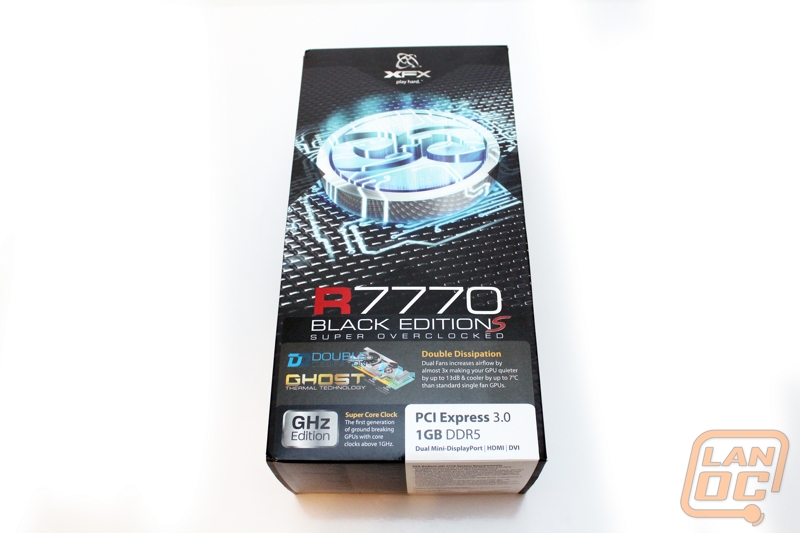

Inside we have the amazing black box, it’s hard not to get excited when you see this box, even when you know what is inside!

First we have all of the R7770’s accessories. You have an HDMI to DVI adapter for those who need two DVI ports, a crossfire bridge cable, DVI to VGA adapter, and the black edition pouch has XFX’s kick ass case badge inside!

The R7770 comes with all kinds of paperwork. You get a quick install guide, warranty information, drive install CD and guide, documentation on XFX power supplies, and a list of adapters available. You also get the do not disturb door hanger that I always love. XFX has placed your cards serial number and info on this card along with the information needed for registering your card. They also give you a spot to put your username and password in case you ever need to talk to them for support, it’s all right in front of you.

After all of that you have the card itself wrapped up inside of a static protectant bag

Let’s not forget that all of the cooler is covered in a thin plastic that you have to remove before using the card.

Card Layout
At first glance it’s easy to spot the similarities between the XFX R7770 and their R7970. The dual fans, aluminum design, and red labeling strip across the top are all found on its big brother. What you might not be able to see in the photo but is obvious in person are how different these cards really are. Obviously the size difference is there but just comparing coolers alone you will see the price difference just in how they are built. The R7970 was machined down leaving the XFX logo raised and exposed against the black rubberish finish. On the R7770 there is just a black strip painted on with the XFX logo just being a void in the paint. That’s not to say that this isn’t a capable cooler. This is more an observation in the difference in attention to detail given to the cards coolers, something that you should expect when paying almost $600 for your card.


You still get the XFX R7770 logo right on the edge of the card, you will be able to see this one after the card is installed through a side panel window.

For cooling the “Double D” in the card mean stands for double dissipation meaning you get two fans to help push the air over the cards cooler.
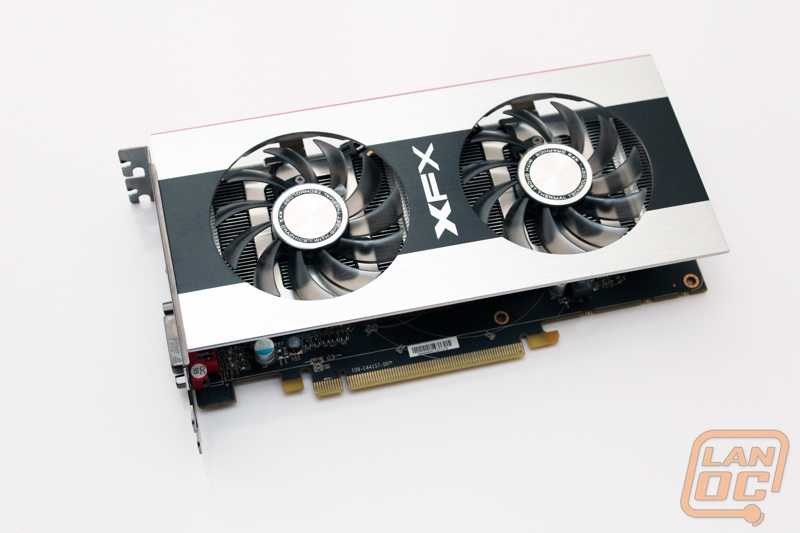

The cooler design is an open air design unlike the R7970’s cooler. That means that the top, bottom, and back are all open in design letting the hot air go into your case after cooling your card down.

I love the flat black PCB design that XFX used on this card. Also noticeable in this photo is that the cooler will be easy to remove if you ever need to. You only have four screws to remove. Of course two of those screws have warranty void if removed on them. Don’t attempt to take them out if you are worried about your warranty.

For the PCI slot we have exact same design we saw on the R7970 and R7950. Half of the vents are shaped into the XFX logo giving it a different look from other cards and according to them, giving it even more air flow. For connections you have two mini display port connections, one HDMI, and a DVI. I love the use of red in the DVI port also, a nice touch.

As mentioned before, the HD 7770 is replacing the HD 6770 and the HD 5770. Here is one of our HD 5770’s next to the R7770 from XFX. Although the new card is slightly longer there are similarities that are still visible.

Our Test Rig
Asus Rampage IV X79 Motherboard (we used the Gigabyte Assassin 2 for this review due to me breaking our Rampage 4 just before testing)
Seagate Constellation 2tb Hard drive
Cooler Master Gold Series 1200 Watt PSU
http://www.highspeedpc.com/ Test Bench
Kingston 1600Mhz DDR3 Quad Channel Ram
Kingston Hyper X 120 SSD’s in Raid 0
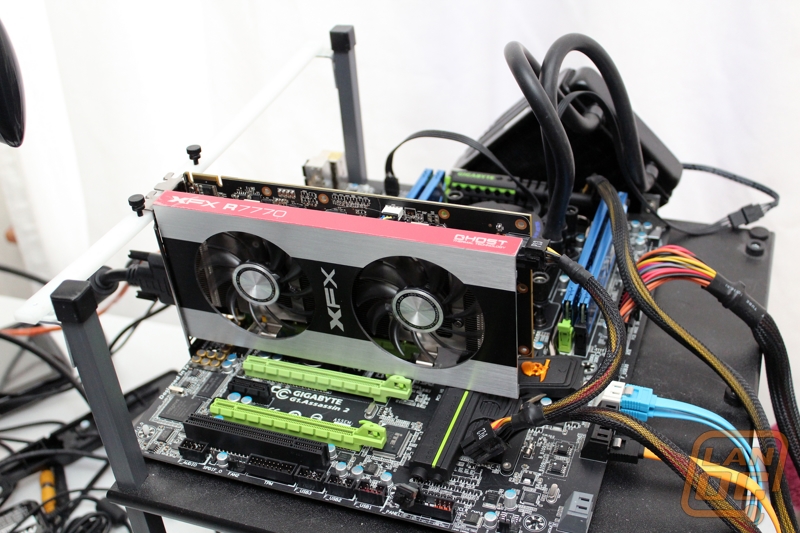
Our Testing Procedures
Battlefield Bad Company 2 (1920x1080 – high settings, first scene starting after the cut scene, recorded using fraps)
Dirt 2 (1920x1080 – 4x MSAA – high settings, in-game benchmark)
Dirt 3 (192x1080 - 4xMSAA - high settings, in-game benchmark)
Metro 2033 DX11 (built-in benchmark, 1920 x 1080; DirectX: DirectX 11; Quality: Very High; Antialiasing: MSAA 4X; Texture filtering: AF 4X; Advanced PhysX: Enabled; Tessellation: Enabled; DOF: Disabled)
Metro 2033 DX10 (built-in benchmark, 1920 x 1080; DirectX: DirectX 10; Quality: Very High; Antialiasing: MSAA 4X; Texture filtering: AF 4X; Advanced PhysX: Enabled; Tessellation: Enabled; DOF: Disabled)
Total War: Shogun 2 Direct X11 Benchmark High setting
Crysis 2 Using Adrenaline Crysis 2 benchmark two runs. The first set of runs set to ultra-settings, 1080p, 4x Anti-Aliasing, DX11, Laplace Edge Detection Edge AA, on the Times Square map, with hi res textures turned on. The second benchmark set to Xtreme at 1080p, no AA, DX9, Edge Blur, Hi-Res Textures turned off on the Times Square Map.
Battlefield 3 Using Fraps with the game set to Ultra settings with 4x MSAA Antialiasing Deferred, 16X Anisotropic Filter, at 1920x1080.
Synthetic Benchmarks For video cards our synthetic benchmarks are limited to 3DMark Vantage and 3DMark Vantage 2011. 3DMark Vantage is run with PPU turned off with results from both the performance and high settings. In 3DMark Vantage 2011 we run both performance and extreme benchmarks
FurMark We use Furmark to push the video card to the limit and test its cooling performance. Keep in mind that FurMark pushes cards well beyond what they would ever do in game. Our tests are done using the built in 1080p benchmark.
Cooling and Noise
Going into the testing for the R7770 I was a little apprehensive. Our experience with the dual fan R7970 was okay but had noise issues at idle and cooling performance while overclocked wasn’t as good as one would hope. Surprisingly when running the R7770 through Furmark I couldn’t hear the card at all. This combined with a temperature of 63 under load are very impressive. Cranking up the fan speed might even give you even better cooling, not that you would need it.

3DMark
I was really excited to see where the R7770 stands compared to the HD 6000 series cards as well as Nvidia’s offerings. What a better way to compare than with 3Dmark Vantage and 11, they make not always show you real work performance but they are very consistent for comparing cards to each other. The R7770 came in above the HD 6850 and blow the HD 6870 in all of our results. That puts the card in between the GTX 550 Ti and the GTX 560Ti in the Nvidia camp.




In Game Performance
Our in game performance tests range from built in benchmarks from Dirt to Shogun 2 and time demo’s from Crysis2 and Metro 2033. All of our benchmarks are run at 1080p on the games highest settings other than our DX9 and 10 results in Crysis 2 and Metro 2033. Our results as a whole came in just below the HD 6870, just like our 3Dmark testing. For the most part all of the games we played will have to be turned down slightly if you are looking for 60FPS playback. I did find the Battlefield Bad Company 2 gameplay to be smooth even though the sub 60 FPS numbers may not show that. If you are looking at this card you will be able to run just about anything on high settings at a resolution of less than 1080p or games at 1080p on medium to high settings.

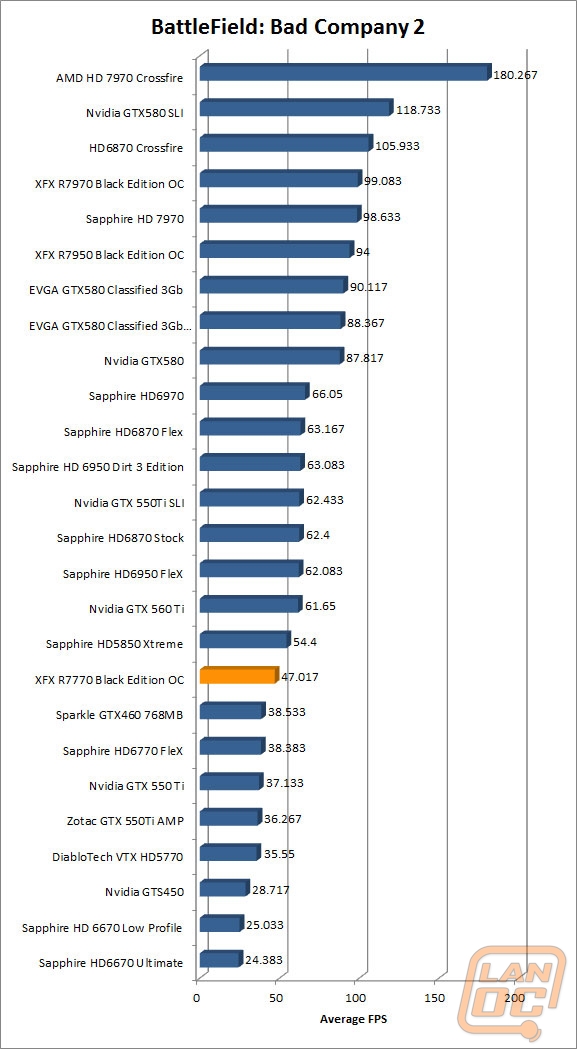



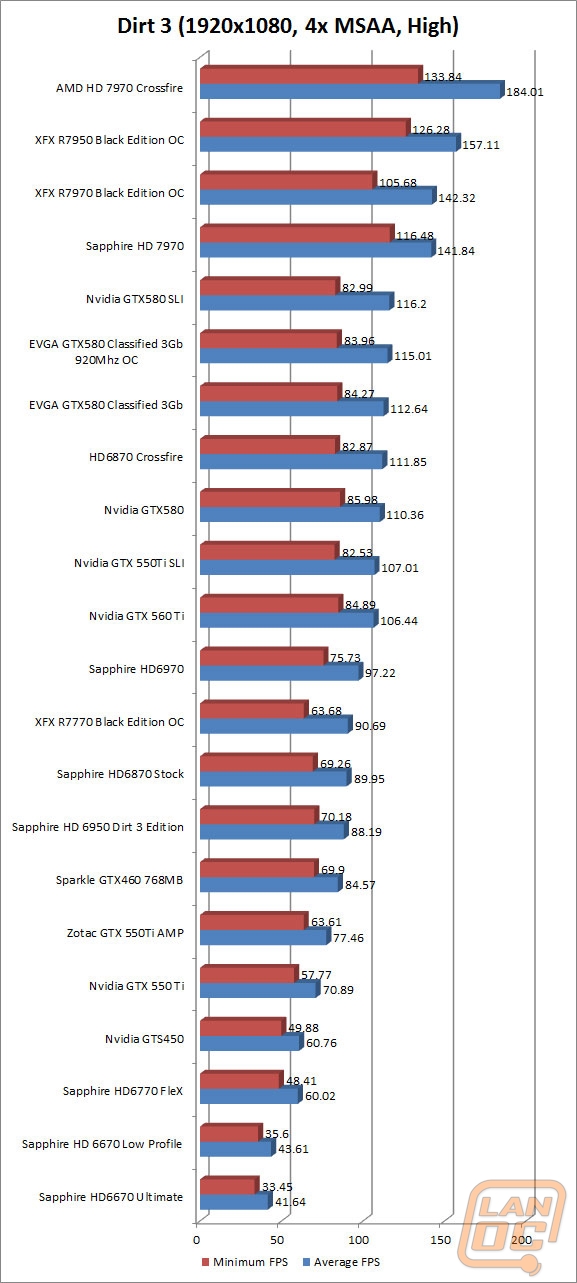



Overall and FV
The R7770 and the HD 7770 cards as a whole come in at an odd price in AMD’s current product lineup. At a MSRP of $159 for the reference design and $179 for the XFX Double D Black Edition that we tested in this review both cards fail to outperform the HD 6870 that is currently selling for less ($155 before rebate). I think that the $159 price point isn’t really a bad price and the price premium for the XFX Double D Black Edition. The problem is the previous generation cards are still to available and are at discounted prices as they clear out stock. That as a whole is really disappointing because I think the HD 7770 is a great card and perfect for someone looking for low thermal output, power usage, and just enough performance to be able to enjoy all of today’s top games at medium to high settings. Hopefully as things settle down the price drops down to a price point that will make it a better value. Until then I really can’t recommend picking one up. Based on the price alone I would give this card a 6/10, but its silent performance and low power requirements deserve a little credit. If you are looking for an HD 7770 this is a great card to get, but like I said before the reasons for looking at an HD 7770 card at all are very limited currently.
